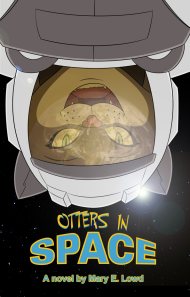Review: 'Otters in Space', by Mary E. Lowd
 Despite the title, the protagonist of Otters in Space, Kipper, is a tabby cat.
Despite the title, the protagonist of Otters in Space, Kipper, is a tabby cat.
The bus stop sign and shelter were in front of a giant, white church. The Church of the First Race was an historical building, preserved from the time when humans still walked the Earth. It dwarfed the taller but smaller-scale high-rises around it. It was the oldest building in New LA. Kipper had been inside once and sat on the monstrous pews, but, like most cats, she didn’t feel comfortable with First Race doctrine. It was a dog religion – they preached that humans, the First Race, had left Earth as emissaries to the stars and would return to bring all the peoples of Earth into a confederation of interstellar sentience. Someday. (p. 1)
“Otters in Space: The Search for Cat Havana”, by Mary E. Lowd.
FurPlanet Publications, January 2012, 2nd Ed.; trade paperback $9.95 (176 pages); ebook $5.99.
Kipper Brighton is the unobtrusive one of her family. Her sister, the always-hyper Petra, is running for district representative on an it’s-time-we-put-more-cats-into-the-government platform. Cats outnumber dogs by four to one in the population, but only one of the forty-six representatives is a cat – and that’s one cat too many, as far as a lot of dogs are concerned, especially those antagonistic toward Petra’s in-your-face style of campaigning.
Kipper, as a temp, gets a lot of short-lived jobs, but many lately have been with Luna Tech, the cat/dog company that deals with the otters’ Moon-based colony.
‘What happened to the cat I’m replacing?’ Kipper asked.
‘Violet?’ Cheryl [a white miniature poodle] shrugged. ‘No one knows. She didn’t show up for work on Monday, and we haven’t heard from her since. Is there anything else you need?’
‘No...’ Kippur answered, setting down a pawful of Petra’s fliers on the desk. It was strange, but this was the fifth cat she’d temped for at Luna Tech in the last year. If they had quit or called in sick, that would be one thing, but each of these five cats had simply stopped showing up. She wondered what kept happening to them. Why wasn’t anyone worried about all these disappearing cats? (pgs. 10-11)
Kipper finds cryptic scraps in Violet’s desk that, by a stretch of the imagination, could hint that she and the other missing cats have snuck away to a secret cat haven in Ecuador. It seems far-fetched, but Petra enthusiastically accepts it. So when a big, black dog comes to kill Kipper (apparently hired by her own cat boss, Sahalie, for finding out too much), and Petra disappears, leaving a GONE TO ECUADOR! BACK SOON note, it seems perfectly logical. Kipper persuades the ditzy but basically friendly would-be assassin, Trudith – “Black lab mutts weren’t always the brightest.” (p. 45) -- to drive her through Mexico and Central America to Ecuador to follow after Petra.
The ten lanes of concrete were dead in the dark of night, and Trudith’s headlights were the only light around. It was rumored that the freeways in the area had remained unchanged since the time of humans, except for normal maintenance and repainting the white, yellow, and dotted lines. It was also rumored that the freeway was only six lanes wide, total, back then.
Corroded, rust orange skeletons of human cars had been found in junkyards and among the ruined human cities. The dinosaur cars were monsters compared to today’s vehicles. Just like human buildings. Just like humans themselves. Kipper couldn’t understand why dogs worshipped them, waiting for them to return. If humans had been so great, they wouldn’t have left cats – that is, THE WORLD – in the condition it was in. They wouldn’t have taken off into space and just ABANDONED everyone. Kipper could feel the darkness making her thoughts morbid. (p. 35)
 Ecuador may or may not be the home of a secret “Cat Havana”, but it is certainly the well-known terminal of the Space Elevator leading to the otter-run Moonville Funpark and the otter-designed Deep Sky Anchor space station. Kipper can believe more easily in a hidden cat paradise in space than in Ecuador, so she doesn’t waste any time searching in Guayaquil; she heads right for the space elevator.
Ecuador may or may not be the home of a secret “Cat Havana”, but it is certainly the well-known terminal of the Space Elevator leading to the otter-run Moonville Funpark and the otter-designed Deep Sky Anchor space station. Kipper can believe more easily in a hidden cat paradise in space than in Ecuador, so she doesn’t waste any time searching in Guayaquil; she heads right for the space elevator.
The last 100+ pages tell what Kipper finds in “otter space”. It is a fast-paced blend of hard-astronautical tech run by anthropomorphic animals, and a more complex political situation than she had expected between the cats, dogs, and otters. It’s much more dazzling than she had guessed. All three species have both friendly and unfriendly members. There are other species, too. The space station has an immigrant-squirrel-run restaurant. One of the otters’ space tugs has a giant octopus cook! The otter-run space station and spaceships are so convincingly and appealingly described, even for humans, that I want to go there!
The basic plot – find the missing sister and the secret cat sanctuary – is pretty simplistic, but the details of Kipper’s world are intriguing. The intelligent animals are not imitation humans of conveniently equal size, as in most Furry fiction:
While the Chow groped for another bottle, Kipper made her escape. She pivoted around, dropped to all fours, and hastily loped away. (p. 8)
After a quick roadside lesson in handling Trudith’s vehicle, Kipper adjusted the seat to accommodate her smaller stature. She had to slide the chair almost all the way forward for her feet to reach the pedals. Nonetheless, it was a nice car. A VERY nice car. (p. 46)
The furry peoples of the world could never be as deeply attached to clothing as all the history books suggested that humans had once been. It’s just not practical to get too attached to a coat of cotton when you’re already wearing a coat of the finest fur. (pgs. 89-90)
Otters in Space seems to get off to a pedestrian start, but quickly won me over. It is too bad that it can’t qualify for an Ursa Major Award again.
The 1st edition of Otters in Space was published by Smashwords as an e-book in July 2010, and by CreateSpace in paperback in August 2010. It sold so well, and was a finalist for the Ursa Major Award for Best Anthropomorphic Novel of 2010, that FurPlanet has picked it up for this trade paperback edition, with a new cover by Doc Marcus.
See also: Otters in Space reviewed by dronon
About the author
Fred Patten — read stories — contact (login required)a retired former librarian from North Hollywood, California, interested in general anthropomorphics
Comments
Post new comment